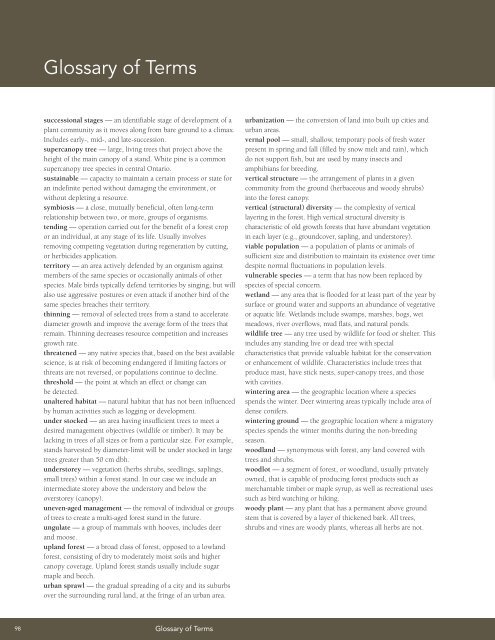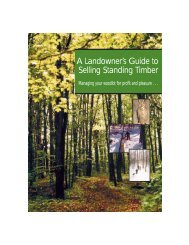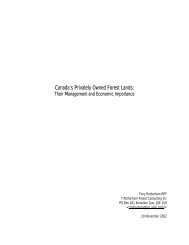A land manager's guide to conserving habitat for forest birds in ...
A land manager's guide to conserving habitat for forest birds in ...
A land manager's guide to conserving habitat for forest birds in ...
You also want an ePaper? Increase the reach of your titles
YUMPU automatically turns print PDFs into web optimized ePapers that Google loves.
Glossary of Terms<br />
successional stages — an identifiable stage of development of a<br />
plant community as it moves along from bare ground <strong>to</strong> a climax.<br />
Includes early-, mid-, and late-succession.<br />
supercanopy tree — large, liv<strong>in</strong>g trees that project above the<br />
height of the ma<strong>in</strong> canopy of a stand. White p<strong>in</strong>e is a common<br />
supercanopy tree species <strong>in</strong> central Ontario.<br />
susta<strong>in</strong>able — capacity <strong>to</strong> ma<strong>in</strong>ta<strong>in</strong> a certa<strong>in</strong> process or state <strong>for</strong><br />
an <strong>in</strong>def<strong>in</strong>ite period without damag<strong>in</strong>g the environment, or<br />
without deplet<strong>in</strong>g a resource.<br />
symbiosis — a close, mutually beneficial, often long-term<br />
relationship between two, or more, groups of organisms.<br />
tend<strong>in</strong>g — operation carried out <strong>for</strong> the benefit of a <strong>for</strong>est crop<br />
or an <strong>in</strong>dividual, at any stage of its life. Usually <strong>in</strong>volves<br />
remov<strong>in</strong>g compet<strong>in</strong>g vegetation dur<strong>in</strong>g regeneration by cutt<strong>in</strong>g,<br />
or herbicides application.<br />
terri<strong>to</strong>ry — an area actively defended by an organism aga<strong>in</strong>st<br />
members of the same species or occasionally animals of other<br />
species. Male <strong>birds</strong> typically defend terri<strong>to</strong>ries by s<strong>in</strong>g<strong>in</strong>g, but will<br />
also use aggressive postures or even attack if another bird of the<br />
same species breaches their terri<strong>to</strong>ry.<br />
th<strong>in</strong>n<strong>in</strong>g — removal of selected trees from a stand <strong>to</strong> accelerate<br />
diameter growth and improve the average <strong>for</strong>m of the trees that<br />
rema<strong>in</strong>. Th<strong>in</strong>n<strong>in</strong>g decreases resource competition and <strong>in</strong>creases<br />
growth rate.<br />
threatened — any native species that, based on the best available<br />
science, is at risk of becom<strong>in</strong>g endangered if limit<strong>in</strong>g fac<strong>to</strong>rs or<br />
threats are not reversed, or populations cont<strong>in</strong>ue <strong>to</strong> decl<strong>in</strong>e.<br />
threshold — the po<strong>in</strong>t at which an effect or change can<br />
be detected.<br />
unaltered <strong>habitat</strong> — natural <strong>habitat</strong> that has not been <strong>in</strong>fluenced<br />
by human activities such as logg<strong>in</strong>g or development.<br />
under s<strong>to</strong>cked — an area hav<strong>in</strong>g <strong>in</strong>sufficient trees <strong>to</strong> meet a<br />
desired management objectives (wildlife or timber). It may be<br />
lack<strong>in</strong>g <strong>in</strong> trees of all sizes or from a particular size. For example,<br />
stands harvested by diameter-limit will be under s<strong>to</strong>cked <strong>in</strong> large<br />
trees greater than 50 cm dbh.<br />
unders<strong>to</strong>rey — vegetation (herbs shrubs, seedl<strong>in</strong>gs, sapl<strong>in</strong>gs,<br />
small trees) with<strong>in</strong> a <strong>for</strong>est stand. In our case we <strong>in</strong>clude an<br />
<strong>in</strong>termediate s<strong>to</strong>rey above the unders<strong>to</strong>ry and below the<br />
overs<strong>to</strong>rey (canopy).<br />
uneven-aged management — the removal of <strong>in</strong>dividual or groups<br />
of trees <strong>to</strong> create a multi-aged <strong>for</strong>est stand <strong>in</strong> the future.<br />
ungulate — a group of mammals with hooves, <strong>in</strong>cludes deer<br />
and moose.<br />
up<strong>land</strong> <strong>for</strong>est — a broad class of <strong>for</strong>est, opposed <strong>to</strong> a low<strong>land</strong><br />
<strong>for</strong>est, consist<strong>in</strong>g of dry <strong>to</strong> moderately moist soils and higher<br />
canopy coverage. Up<strong>land</strong> <strong>for</strong>est stands usually <strong>in</strong>clude sugar<br />
maple and beech.<br />
urban sprawl — the gradual spread<strong>in</strong>g of a city and its suburbs<br />
over the surround<strong>in</strong>g rural <strong>land</strong>, at the fr<strong>in</strong>ge of an urban area.<br />
urbanization — the conversion of <strong>land</strong> <strong>in</strong><strong>to</strong> built up cities and<br />
urban areas.<br />
vernal pool — small, shallow, temporary pools of fresh water<br />
present <strong>in</strong> spr<strong>in</strong>g and fall (filled by snow melt and ra<strong>in</strong>), which<br />
do not support fish, but are used by many <strong>in</strong>sects and<br />
amphibians <strong>for</strong> breed<strong>in</strong>g.<br />
vertical structure — the arrangement of plants <strong>in</strong> a given<br />
community from the ground (herbaceous and woody shrubs)<br />
<strong>in</strong><strong>to</strong> the <strong>for</strong>est canopy.<br />
vertical (structural) diversity — the complexity of vertical<br />
layer<strong>in</strong>g <strong>in</strong> the <strong>for</strong>est. High vertical structural diversity is<br />
characteristic of old growth <strong>for</strong>ests that have abundant vegetation<br />
<strong>in</strong> each layer (e.g., groundcover, sapl<strong>in</strong>g, and unders<strong>to</strong>rey).<br />
viable population — a population of plants or animals of<br />
sufficient size and distribution <strong>to</strong> ma<strong>in</strong>ta<strong>in</strong> its existence over time<br />
despite normal fluctuations <strong>in</strong> population levels.<br />
vulnerable species — a term that has now been replaced by<br />
species of special concern.<br />
wet<strong>land</strong> — any area that is flooded <strong>for</strong> at least part of the year by<br />
surface or ground water and supports an abundance of vegetative<br />
or aquatic life. Wet<strong>land</strong>s <strong>in</strong>clude swamps, marshes, bogs, wet<br />
meadows, river overflows, mud flats, and natural ponds.<br />
wildlife tree — any tree used by wildlife <strong>for</strong> food or shelter. This<br />
<strong>in</strong>cludes any stand<strong>in</strong>g live or dead tree with special<br />
characteristics that provide valuable <strong>habitat</strong> <strong>for</strong> the conservation<br />
or enhancement of wildlife. Characteristics <strong>in</strong>clude trees that<br />
produce mast, have stick nests, super-canopy trees, and those<br />
with cavities.<br />
w<strong>in</strong>ter<strong>in</strong>g area — the geographic location where a species<br />
spends the w<strong>in</strong>ter. Deer w<strong>in</strong>ter<strong>in</strong>g areas typically <strong>in</strong>clude area of<br />
dense conifers.<br />
w<strong>in</strong>ter<strong>in</strong>g ground — the geographic location where a migra<strong>to</strong>ry<br />
species spends the w<strong>in</strong>ter months dur<strong>in</strong>g the non-breed<strong>in</strong>g<br />
season.<br />
wood<strong>land</strong> — synonymous with <strong>for</strong>est, any <strong>land</strong> covered with<br />
trees and shrubs.<br />
woodlot — a segment of <strong>for</strong>est, or wood<strong>land</strong>, usually privately<br />
owned, that is capable of produc<strong>in</strong>g <strong>for</strong>est products such as<br />
merchantable timber or maple syrup, as well as recreational uses<br />
such as bird watch<strong>in</strong>g or hik<strong>in</strong>g.<br />
woody plant — any plant that has a permanent above ground<br />
stem that is covered by a layer of thickened bark. All trees,<br />
shrubs and v<strong>in</strong>es are woody plants, whereas all herbs are not.<br />
98<br />
Glossary of Terms

















